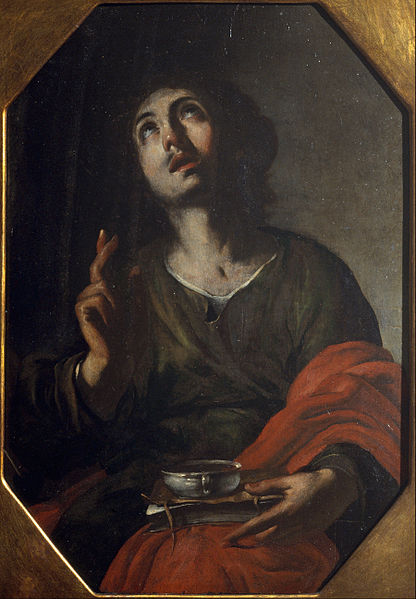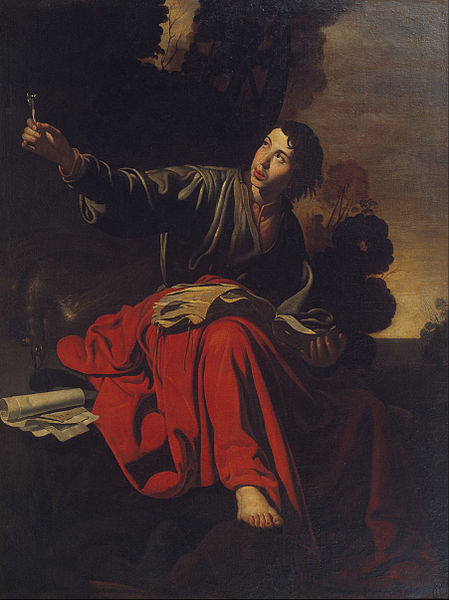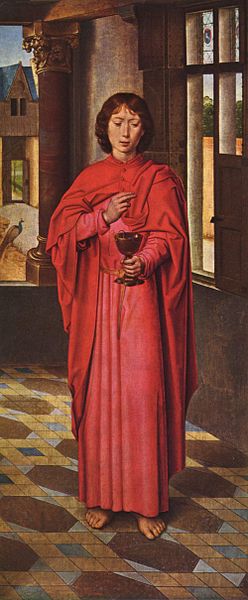<Back to Index>
- Apostle John, 6
PAGE SPONSOR



John the Apostle (Aramaic Yoħanna, Koine Greek Ἰωάννης) (c. AD 6 - c. 100) was one of the Twelve Apostles of Jesus. He was the son of Zebedee and Salome and brother of James, son of Zebedee, another of the Twelve Apostles. Christian tradition holds that he outlived the remaining apostles — all of whom suffered martyrdom (except Judas Iscariot) — and ultimately died of natural causes "in great old age in Ephesus" at the beginning of the second century. The Church Fathers consider him the same person as John the Evangelist, John of Patmos and the Beloved Disciple.
The Church Fathers generally identify him as the author of five books in the New Testament: the Gospel of John, three Epistles of John, and the Book of Revelation. The Gospel according to John differs considerably from the synoptic gospels, likely written decades earlier than John's Gospel. The bishops of Asia Minor supposedly requested him to write his gospel to deal with the heresy of the Ebionites, who asserted that Christ did not exist before Mary. John probably knew and undoubtedly approved of the Gospels of Matthew, Mark and Luke, but these gospels spoke of Jesus primarily in the year following the imprisonment and death of John the Baptist. Around 600, however, Sophronius of Jerusalem noted that "two epistles bearing his name ... are considered by some to be the work of a certain John the Elder" and, while stating that Revelation was written by John on Patmos, it was “later translated by Justin Martyr and Irenaeus”, presumably in an attempt to reconcile tradition with the obvious differences in Greek style. On the other hand, many authors in those days employed secretaries often called scribes whose personal styles influenced the final documents. John perhaps employed different scribes for his several works who dictated his words.
Some modern scholars have raised the possibility that
John the Apostle, John the Evangelist, and John of Patmos
were three separate individuals. Certain lines of evidence
suggest that John of Patmos wrote Revelation but neither
the Gospel of John nor the Epistles of John. For one, the
author of Revelation identifies himself as "John" several
times, but the author of the Gospel of John never
identifies himself directly. Some Catholic scholars state
that "vocabulary, grammar, and style make it doubtful that
the book could have been put into its present form by the
same person(s) responsible for the fourth gospel".
John the Apostle was the son of Zebedee and the younger brother of James, son of Zebedee (Saint James the Greater). Tradition, based on Sacred Scripture, considers Salome their mother. James and John were the cousins of Jesus and their mother Salome was the younger sister of Mary, the mother of Jesus. Zebedee and his sons fished in the Lake of Genesareth. James and John first were disciples of Saint John the Baptist, their second cousin. Jesus then called Saint Peter and Saint Andrew, and these two sons of Zebedee to follow him. James and John did so and thus rank high among the Twelve Apostles of Jesus. James and John both held prominent positions for not only being the first of the disciples to be called but also because of their relationship to Jesus among the Apostles. Jesus referred to the pair collectively as "Boanerges" (translated "sons of thunder") being that although their nature was of a calm and gentle manner, when their patience was pushed to its limits their anger became wild, fierce and thunderous causing them to speak out like an untamed storm. At one point John and his brother James wanted to call down fire on a Samaritan town, but Jesus rebuked them. John survived James by more than half a century after James became the first Apostle to die a martyr's death.
Peter, James and John were the only witnesses of the raising of Daughter of Jairus. All three also witnessed the Transfiguration, and these same three witnessed the Agony in Gethsemane more closely than the other Apostles did.
Jesus sent only John and Peter into the city to make the preparation for the final Passover meal (the Last Supper). At the meal itself, the "disciple whom Jesus loved" sat next to Jesus and leaned onto his chest. Tradition identifies this disciple as Saint John. After the arrest of Jesus, Peter and the "other disciple" (according to Sacred Tradition, John) followed him into the palace of the high priest.
John alone among the Apostles remained near Jesus at the
foot of the cross on Calvary alongside myrrhbearers and
numerous other women; following the instruction of Jesus
from the Cross, John took Mary,
the mother of Jesus, into his care as the last
legacy of Jesus. After Jesus’ Ascension and the descent
of the Holy Spirit on Pentecost, John, together with
Peter, took a prominent part in the founding and
guidance of the church. He is with Peter at the healing
of the lame man in the Temple.
With Peter he is also thrown into prison. He is also with Peter visiting
the newly converted in Samaria.
There is no other information in the Bible concerning the duration of this activity in Judea. According to tradition, John and the other Apostles remained some 12 years in this first field of labor, until the persecution of Herod Agrippa I led to the scattering of the Apostles through the various provinces of the Roman Empire.
In any case, a messianic community was already in existence at Ephesus before Paul's first labors there (cf. "the brethren"), in addition to Priscilla and Aquila. The original community was under the leadership of Apollo (1 Corinthians 1:12). They were disciples of St. John the Baptist, and were converted by Aquila and Priscilla. Then came St. Paul.
While he remained in Judea and the surrounding area, the other disciples returned to Jerusalem for the Apostolic Council (about AD 51). Paul, in opposing his enemies in Galatia, recalls that John explicitly, along with Peter and James the Just, were referred to as "pillars of the church" and refers to the recognition that his Apostolic preaching of a gospel free from Jewish Law received from these three, the most prominent men of the messianic community at Jerusalem.
Of the other New Testament writings, it is only from the three Letters of John and the Book of Revelation that anything further might be learned about John, if we assume that he was the author of these books. From the Letters and Revelation we may suppose that John belonged to the multitude of personal eyewitnesses of the life and work of Jesus (cf. especially 1 Jn 1:1-5; 4:14), that he had lived for a long time in Asia Minor, was thoroughly acquainted with the conditions existing in the various messianic communities there, and that he had a position of authority recognized by all messianic communities as leader of this part of the church. Moreover, the Book of Revelation says that its author was on the island of Patmos "for the word of God and for the testimony of Jesus", when he was honored with the vision contained in Revelation.
Though some scholars agree in placing the Gospel of John somewhere between AD 65 and 85, John A.T. Robinson proposes an initial edition by 50-55 and then a final edition by 65 due to narrative similarities with Paul. Other critical scholars are of the opinion that John was composed in stages (probably two or three). There is also a strongly held view among contemporary scholars that the Gospel was not written until the latter third of the first century CE. The Dean of New Testament at Wake Forest University School of Divinity, Gail R O'Day, writes in her introduction to the Gospel in the New Revised Standard Translation of the Bible "...a date of 75-80 CE as the earliest possible date of composition for this Gospel". Other reliable scholars are convinced that an even later date, perhaps even the last decade of the first century CE right up to the start of the 2nd century (i.e., 90 - 100) is applicable.
The Eastern Orthodox Church and those Eastern Catholic Churches which follow the Byzantine Rite commemorate the "Repose of the Holy Apostle and Evangelist John the Theologian" on September 26. On May 8 they celebrate the "Feast of the Holy Apostle and Evangelist John the Theologian", on which date Christians used to draw forth from his grave fine ashes which were believed to be effective for healing the sick.
Until 1960, another feast day which appeared in the General Roman Calendar is that of "Saint John Before the Latin Gate" on May 6, celebrating a tradition recounted by Jerome that St John was brought to Rome during the reign of the Emperor Domitian, and was thrown in a vat of boiling oil, from which he was miraculously preserved unharmed. A church (San Giovanni a Porta Latina) dedicated to him was built near the Latin gate of Rome, the traditional site of this event.
Other Christians highly revere him but do not canonize or venerate saints.
Until the 19th century, the authorship of the Gospel of
John had universally been attributed to the Apostle John.
However, critical scholars since then have had their
doubts. The Gospel does not make that attribution.
Instead, authorship is internally credited to the disciple
whom Jesus loved ("ο μαθητης ον ηγαπα ο Ιησους") in
John 20:2.
The term the Beloved Disciple ("ον εφιλει ο
Ιησους") is used five times in the Gospel of John to
indicate authorship. John 21:24
claims that the Gospel of John is based on the written
testimony of the "Beloved Disciple".
Roman Catholic tradition states that after the Assumption, John went to Ephesus and from there wrote the three epistles traditionally attributed to him. John was allegedly banished by the Roman authorities to the Greek island of Patmos, where some believe that he wrote the Book of Revelation. According to Tertullian (in The Prescription of Heretics) John was banished (presumably to Patmos) after being plunged into boiling oil in Rome and suffering nothing from it. It is said that all in the entire Colosseum audience were converted to Christianity upon witnessing this miracle. This event would have occurred during the reign of Domitian, a Roman emperor who was known for his persecution of Christians in the late 1st century.
When John was aged, he trained Polycarp who later became Bishop of Smyrna. This was important because Polycarp was able to carry John's message to future generations. Polycarp taught Irenaeus, and passed on to him stories about John. In Against Heresies, Irenaeus relates how Polycarp told a story of
| “ | John, the disciple of the Lord, going to bathe at Ephesus, and perceiving Cerinthus within, rushed out of the bath - house without bathing, exclaiming, "Let us fly, lest even the bath - house fall down, because Cerinthus, the enemy of the truth, is within." | ” |
It is traditionally believed that John survived his contemporary apostles and lived to an extreme old age, dying naturally at Ephesus in about AD 100. An alternative account of John's death, ascribed by later Christian writers to the early second century bishop Papias of Hierapolis, claims that he was slain by the Jews. Most Johannine scholars doubt the reliability of its ascription to Papias, but a minority, including B.W. Bacon, Martin Hengel and Henry Barclay Swete, maintain that these references to Papias are credible. John's traditional tomb is thought to be located at Selçuk, a small town in the vicinity of Ephesus.
In art, John as the presumed author of the Gospel is
often depicted with an eagle, which symbolizes the height
he rose to in the first chapter of his gospel. In Orthodox
icons, he is often depicted looking up into heaven and
dictating his Gospel (or the Book of Revelation) to his
disciple, traditionally named Prochorus.
Before Jesus ascended, he charged John with watching over the newly established Church. He was then established as a pillar at the Church of Jerusalem. While dying on the cross, he asked John to take care of Mary, his mother, a duty which John fulfilled even after Christ's resurrection up until her death. At the time John was the only apostle present at the crucifixion, despite being the youngest of all twelve apostles. Jesus told his disciples how they would meet their end with the exception of John and this irked Peter.
It was after the outpouring of the Holy Spirit on Pentecost where they were gathered in one place that John spent much of his time in Judea and in the surrounding lands preaching the gospel. He accompanied Peter through the temple one day and the Holy Spirit on their behest healed a lame beggar. The people in the temple were amazed and Peter testified to them and then again to the Jewish Council. They were arrested but later freed. In that day, Herod the king committed violence against some who belonged to the church. He killed James the brother of John the Beloved with the sword, and when he saw that it pleased the Jews, he proceeded to arrest Peter also. This was during the days of Unleavened Bread. And when he had seized him, he put him in prison, delivering him over to four squads of soldiers to guard him, intending after the Passover to bring him out to the people. So Peter was kept in prison, but earnest prayer for him was made to God by the church. He was later freed by an angel of God.
In 54 AD, Mary the mother of Jesus died and was buried and so John fulfilled his duty of caring for her until the very end. It was said that when they opened the tomb her body was gone. Catholic tradition says she rose from the dead and ascended into Heaven with both body and soul intact in what is called the Assumption of Mary, however others say her body was taken away lest it become an idol. John and Mary Magdalene went north and visited the churches that were established along the way. They travel as far as Asia Minor and settle in Ephesus. One night, while they slept a thief broke into their home and John confronted him, converted him to the faith, and told him turn from doing evil. The thief’s name was Cleophus whose name means "vision of glory". This story was shared among the Church and it became used as another example to describe the second coming of Christ as “thief in the night”.
John, one day, was going to bathe at Ephesus, and perceiving Cerinthus within, he then rushed out of the bath - house without bathing, exclaiming, "Let us fly, lest even the bath-house fall down, because Cerinthus, the enemy of the Truth, is within.” He wrote three epistles while living in Ephesus, and he also completed the Gospel of John during this period. John was taken away in the persecution of the Roman emperors in Ephesus, leaving Mary Magdalene in the care of Cleophus. Eastern Orthodox tradition states Mary Magdalene went to Cyprus to be with her sister Martha, where Lazarus became the first Bishop of Kittim (modern Larnaca). All three died in Cyprus. Catholic tradition says she later traveled to France and lived out her days there in penance.
After having spent time imprisoned in Rome during the
reign of Roman Emperor Domitian, John was sentenced to be
boiled in oil at the Colosseum. However he endured no harm
or suffering from the scalding oil. It is said that all in
the entire Colosseum audience were converted to
Christianity upon witnessing this miracle. John was then
sent by the Roman authorities to the Greek island of
Patmos, where he wrote the Book of Revelation (Rev 1:9) and where it is
said he was later freed. When John was aged, he trained
Polycarp who later became Bishop of Smyrna. Polycarp in
turn taught Irenaeus and passed on to him stories about
John. The only one of the Apostles who was not martyred,
John testified that God has kept him alive for Himself and
his service. Surrounded by his closest friends in Ephesus,
he closed his eyes and died at age 94 in 100 AD.
He is venerated as a saint by the Roman Catholic Church and the Anglican Communion who commemorate him as "John, Apostle and Evangelist" on December 27.
The Eastern Orthodox Church and those Eastern Catholic Churches which follow the Byzantine Rite commemorate the "Repose of the Holy Apostle and Evangelist John the Theologian" on September 26. On May 8 they celebrate the "Feast of the Holy Apostle and Evangelist John the Theologian", on which date Christians used to draw forth from his grave fine ashes which were believed to be effective for healing the sick.
Until 1960, another feast day which appeared in the General Roman Calendar is that of "St John Before the Latin Gate" on May 6, celebrating a tradition recounted by Jerome that St John was brought to Rome during the reign of the Emperor Domitian, and was thrown in a vat of boiling oil, from which he was miraculously preserved unharmed. A church (San Giovanni a Porta Latina) dedicated to him was built near the Latin gate of Rome, the traditional scene of this event.
Other Christians highly revere him but do not canonize or venerate saints.
The Qur'an also speaks of Jesus's disciples but does not mention their names, instead referring to them as "helpers to the work of God". Muslim exegesis and Qur'an commentary, however, names them and includes John among the disciples. An old tradition, which involves the legend of Habib the Carpenter, mentions that John was one of the three disciples sent to Antioch to preach to the people there.